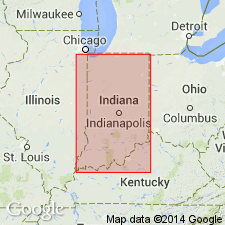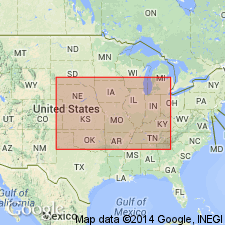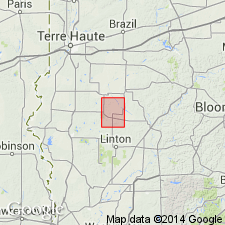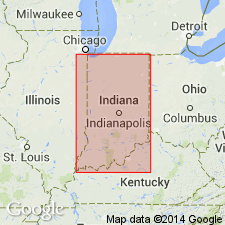
- Usage in publication:
-
- Staunton formation
- Modifications:
-
- Original reference
- AAPG geologic province:
-
- Illinois basin
Summary:
Chart and p. 408, 525, 529. Staunton formation. Name proposed for interval between top of coal No. 4 and top of coal No. 2 of Indiana. Formerly included in Brazil formation. Rests disconformably on Brazil formation as here restricted and is diconformably overlain by Petersburg formation as here expanded. Age is Pennsylvanian (Allegheny).
Named from Staunton, Clay Co., southwestern IN.
Source: US geologic names lexicon (USGS Bull. 896, p. 2057).

- Usage in publication:
-
- Staunton formation
- Modifications:
-
- Revised
- AAPG geologic province:
-
- Illinois basin
Summary:
Chart 6 (column 25). Staunton formation. Shown on Pennsylvanian correlation chart as including Velpen limestone. Age is Middle Pennsylvanian.
Source: US geologic names lexicon (USGS Bull. 1200, p. 3713).

- Usage in publication:
-
- Staunton formation*
- Modifications:
-
- Revised
- Mapped
- Dominant lithology:
-
- Sandstone
- Shale
- AAPG geologic province:
-
- Illinois basin
Summary:
Staunton formation. Described in Clay, Greene, and Sullivan Counties, southwestern Indiana. As defined by Cumings contained Coals III, IIIa, and IV. Stratigraphic break is present above Coal III and Staunton is here restricted to rocks above this break and unconformity above Coal II. Restricted Staunton comprises sandstone and shale, and averages about 85 feet in thickness. Remainder of Staunton as originally defined is assigned to Linton formation (new). Overlies Brazil formation (not exposed in area of this report, Jasonville quadrangle).
Source: US geologic names lexicon (USGS Bull. 1200, p. 3713).

- Usage in publication:
-
- Staunton Formation
- Modifications:
-
- Overview
- AAPG geologic province:
-
- Illinois basin
Summary:
Pg. 149-150, pls. Staunton Formation, upper formation of Raccoon Creek Group. Consists of sandstone and shale, and as many as 8 coal beds. Thickness 75 to 150 feet (23 to 46 m). Interval between top of Minshall Coal Member of Brazil Formation (Raccoon Creek Group) and base of Coxville Sandstone Member of Linton Formation (Carbondale Group). Includes (ascending): Perth Limestone Member, Holland Limestone Member, Silverwood Limestone Member, and Seelyville Coal Member. Probable equivalents are uppermost part of Tradewater Formation and lowermost part of Carbondale Formation of Kentucky, and part of Spoon Formation of Illinois. Age is Middle Pennsylvanian (early Desmoinesian). Authors believe Atokan-Desmoinesian boundary should be placed at base of formation; basal limestone beds yielded FUSULINELLA IOWAENSIS and ostracod AMPHISSITES CENTRONOTUS. Report includes map of type sections-localities-areas, correlation chart.
Indiana geologists consider type locality to be in T. 12 N., R. 7 W., northern Clay Co., southwestern IN.
Source: Publication.
For more information, please contact Nancy Stamm, Geologic Names Committee Secretary.
Asterisk (*) indicates published by U.S. Geological Survey authors.
"No current usage" (†) implies that a name has been abandoned or has fallen into disuse. Former usage and, if known, replacement name given in parentheses ( ).
Slash (/) indicates name conflicts with nomenclatural guidelines (CSN, 1933; ACSN, 1961, 1970; NACSN, 1983, 2005, 2021). May be explained within brackets ([ ]).

